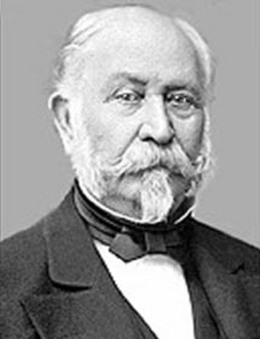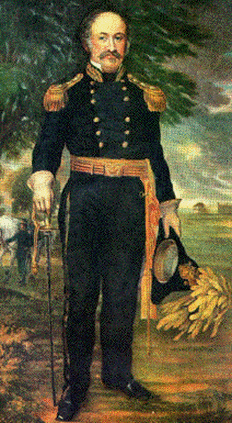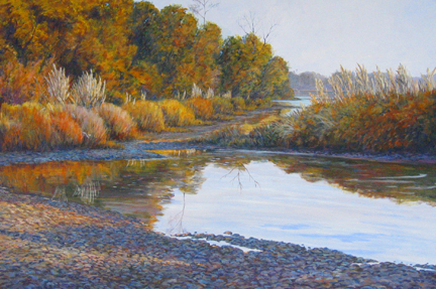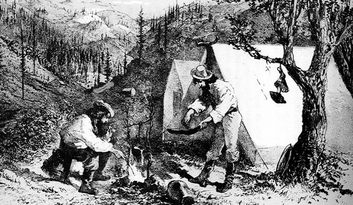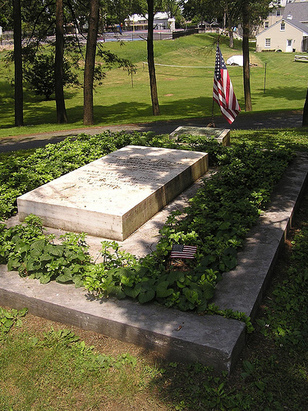John Augustus Sutter
John Augustus Sutter was another extremely famous person from the period of the California Gold Rush. Sutter was, after all, the owner of the mill at which gold was first discovered.
John Sutter was born on February 15, 1803 in Kandern, Baden. Sutter began his life as an apprentice to a business of printers and booksellers. Soon, however, he decided that the paper business was not for him.
While clerking in a draper's shop, Sutter met his soon-to-be wife, Annette D'beld. John and Annette would soon marry in Burgdorf on October 24, 1826.
Throughout his life, Sutter experienced several business failures. These failures all led up to his final decision to seek fortune in America. At age thirty-one, Sutter left Annette and four of their children to set off for the golden country.
John Sutter was born on February 15, 1803 in Kandern, Baden. Sutter began his life as an apprentice to a business of printers and booksellers. Soon, however, he decided that the paper business was not for him.
While clerking in a draper's shop, Sutter met his soon-to-be wife, Annette D'beld. John and Annette would soon marry in Burgdorf on October 24, 1826.
Throughout his life, Sutter experienced several business failures. These failures all led up to his final decision to seek fortune in America. At age thirty-one, Sutter left Annette and four of their children to set off for the golden country.
After arriving in America, John Sutter headed west towards Missouri where he worked as an innkeeper and merchant for several years, doing all of this while dreaming of constructing his own agricultural empire and developing new farming techniques.
In April 1883, he joined a party of trappers that were on their way to the Pacific Coast. The party reached Fort Vancouver in October. Sutter then sailed and landed on Honolulu, Hawaii on December 9, 1838. From there, he sailed to a Russian colony in Sitka, Alaska and then towards Yerba Buena, California on July 1, 1839. John Augustus Sutter had finally reached California.
John Sutter met with Governor Alvarado of California in Monterey to discuss adjusting himself to the new country. Sutter later chartered a ship called "Isabella" and two other, smaller sailing vessels. Stocked with provisions, Sutter led his small fleet up the Sacramento River on August 1, 1839. Two weeks later, they landed near the joint between the American River and Sacramento River and built a camp there.
Sutter later became a Mexican citizen on August 29, 1840 in order to qualify for a land grant. On June 18 of the following year, Sutter recieved eleven leagues of land, approximately 48,827 acres of land, from Governor Alvarado. The land grant was named New Helvetia, after his homeland, and began constructing his empire.
In April 1883, he joined a party of trappers that were on their way to the Pacific Coast. The party reached Fort Vancouver in October. Sutter then sailed and landed on Honolulu, Hawaii on December 9, 1838. From there, he sailed to a Russian colony in Sitka, Alaska and then towards Yerba Buena, California on July 1, 1839. John Augustus Sutter had finally reached California.
John Sutter met with Governor Alvarado of California in Monterey to discuss adjusting himself to the new country. Sutter later chartered a ship called "Isabella" and two other, smaller sailing vessels. Stocked with provisions, Sutter led his small fleet up the Sacramento River on August 1, 1839. Two weeks later, they landed near the joint between the American River and Sacramento River and built a camp there.
Sutter later became a Mexican citizen on August 29, 1840 in order to qualify for a land grant. On June 18 of the following year, Sutter recieved eleven leagues of land, approximately 48,827 acres of land, from Governor Alvarado. The land grant was named New Helvetia, after his homeland, and began constructing his empire.
Sutter's Fort was completed in 1844. The fort was a trading post and became a well-known checkpoint for parties crossing the Sierras.
Over time, Sutter began to branch out in objectives. He later began to fulfill his dream of an agricultural empire as his objectives began to branch out. Sutter hired hunters to go into the mountains for fur and elk skin. Native Americans were hired to sow and harvest the wheat fields. A blacksmith shop was later built to furnish fort tools. A ship was constructed to transport passengers between the fort and San Francisco Bay.
In one of these branches, Sutter hired James Wilson Marshall to build a sawmill. Unfortunately, however, Marshall later discovered gold on the site and began the California Gold Rush. Sutter's Fort was destroyed and his agricultural empire was destroyed. Gold miners trampled the crops, stole his animals, and took whatever tools and supplies the fort had. His workers were soon infected with gold fever as well and nothing could be done as his empire crumbled into nothing.
Over time, Sutter began to branch out in objectives. He later began to fulfill his dream of an agricultural empire as his objectives began to branch out. Sutter hired hunters to go into the mountains for fur and elk skin. Native Americans were hired to sow and harvest the wheat fields. A blacksmith shop was later built to furnish fort tools. A ship was constructed to transport passengers between the fort and San Francisco Bay.
In one of these branches, Sutter hired James Wilson Marshall to build a sawmill. Unfortunately, however, Marshall later discovered gold on the site and began the California Gold Rush. Sutter's Fort was destroyed and his agricultural empire was destroyed. Gold miners trampled the crops, stole his animals, and took whatever tools and supplies the fort had. His workers were soon infected with gold fever as well and nothing could be done as his empire crumbled into nothing.
In 1850, Sutter joined his wife, his daughter Eliza, and sons Emil Victor and William Alphonse after sixteen years. Life became unbearable on the fort and he moved to one of his farms. The family enjoyed the farm for a few years, surrounded by nothing but vineyards, gardens, and orchards. Unfortunately, the peace didn't last long. People found where Sutter's family lived and began destroy the plants and overrun his land. On June 7, 1865 Sutter's life was destroyed when a small group of men set fire to his homeland destroyed everything.
Sutter and his wife went to Washington D.C. in search of reinstatement from Congress, however, they were unsuccessful. He and his wife settled down in the town of Lititz, Pennsylvania around 1871. On June 16, 1880, Congress passed a bill that would have given Sutter fifty-thousand dollars. Misfortune struck again, and John Augustus Sutter died two days later. Sutter's body was returned to Lititz and was buried in the Moravian Brotherhood's Cemetary. Annette Sutter died the following January.
Sutter and his wife went to Washington D.C. in search of reinstatement from Congress, however, they were unsuccessful. He and his wife settled down in the town of Lititz, Pennsylvania around 1871. On June 16, 1880, Congress passed a bill that would have given Sutter fifty-thousand dollars. Misfortune struck again, and John Augustus Sutter died two days later. Sutter's body was returned to Lititz and was buried in the Moravian Brotherhood's Cemetary. Annette Sutter died the following January.
